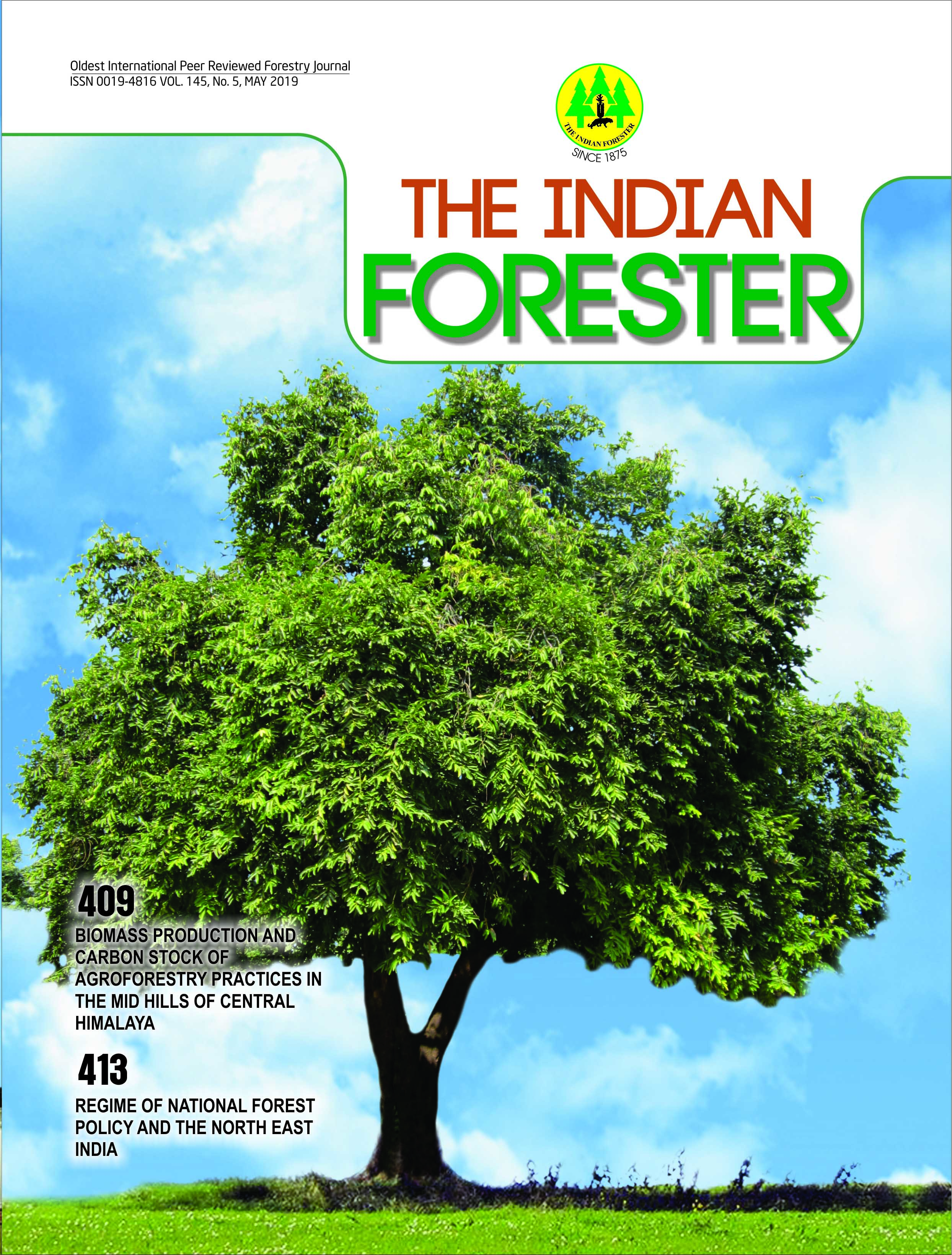Impact of Grading on Quality Seedling Production in Swietenia macrophylla King
DOI:
https://doi.org/10.36808/if/2019/v145i5/145701Keywords:
Big Leaf Mahogany, Plant Percent, Quality Planting Stock, Seedling Grading.Abstract
An experiment was carried out to know the impact of grading on quality seedling production in Swietenia macrophylla King. The seeds (seed rate 1761 seeds kg-1) were collected from middle to mature age mother trees (15 to 18 years) from Arsikere Forest Range (Karnataka) were sowed in raised mother bed and from these 1374 seedlings were obtained with plant percent 78.02%. The 51 days old seedlings were graded in three grades G1 (> 21 cm), G2 (18 to 21 cm) and G3 (< 18 cm) based on seedling height. There were seven replications for each grade (treatment) and each replication contained 30 seedlings. The different growth parameters were recorded with two months interval until the six months growth of seedlings. The grade G1 remained superior to other grades in all recorded parameters. The outcome noticeably displayed that G1 recorded the highest biometric parameters viz., shoot length (50.53 cm), root length (40.23 cm), total plant length (90.76 cm), collar diameter (0.517 cm), number of leaflets (21.03), shoot dry weight (2.4706 g seedling-1), root dry weight (1.7804 g seedling-1), total dry matter production of plant (4.2510 g seedling-1), root/shoot ratio (0.7207) and quality traits like sturdiness quotient (9.79), quality index (0.3812) and volume index (13.55) at 180 DAT. Hence it is confirmed that seedling grading is worthy to produce quality planting stock for better success in out plantings as initially taller seedlings remain taller which may reduce rotation periods specially in fast growing species.References
Bacon G.J., Hawkins P.J. and Jermyn D. (1977). Morphological Grading Studies with1-0 Slash Pine Seedlings. Australian Forestry, 40(4): 293-303.
Bayala J., Dianda M., Wilson J., Ouedraogo S.J. and Sanon K. (2009). Predicting field performance of five irrigated tree species using seedling quality assessment in Burkina Faso, West Africa. New Forest, 38(3): 309-322
Cossitt F.M., Rindt C.A. and Gunning H.A. (1949). Production of planting stock in trees. Yearbook of Agriculture, Govt. Print. Office, Wash., D.C. 160-169.
Curtis R.O. (1955). Use of graded nursery stock for red pine plantations. J. For., 53:171-173.
Davis A.S. and Jacobs D.F. (2005). Quantifying root system quality of nursery seedlings and relationship to out planting performance. New Forest, 30:295-311.
Dey D.C. and Parker W.C. (1997). Morphological indicators of stock quality and field performance of red oak (Quercus rubra L.) seedlings under planted in a central Ontario shelter wood. New Forest, 14(2):145-156.
Diane L.H. (2008). Understanding forest seedling quality : measurements and interpretation. Tree Planter's note, 52(2):24-30.
Grogan J. and Barreto P. (2005). Big-leaf Swietenia macrophylla on CITES Appendix II: big challenge, big opportunity. Conserv. Biol., 19(3): 973-976.
Hatchell, G.E. (1985). In: Proc. Third Bic. South, S.J. Res. Conf. (Shoulders, E., Ed). Atlanta, G.A., Nov. 78: G.T.R. 8084. pp. 395-402.
IUCN (2016). The IUCN red list of threatened species Version 2016-2. www.iucnredlist.org.
Lamb F.B. (1996). Mahogany of tropical America: its ecology and management, Ann. Arbor., Michigan, USA, University of Michigan Press, 220.
Mullin R.E. and Svaston J. (1972). A grading study with white spruce nursery stock. Comm. For. Review, 51:62-69.
Pomeroy K.B., Green F.K. and Burkett L.B. (1949). Importance of stock quality in survival and growth of planted trees. J. For., 47:706-707.
Rawat J.S. and Singh T.P. (2000). Seedling indices of four tree species in nursery and their correlations with field growth in Tamil Nadu, India. Agroforest Syst., 49:289-300.
Ritchie G.A. (1984). Assessing seedling quality. Forestry nursery manual– Production of bare root seedlings (Eds. Duryea, M.L. and Landis, J.D.) Martinus Nijhoftl Dr. W. Junk Publishers, The Hague/Boston/Lancaster. 234-259.
Rose R., Gleason J., Atkinson M. and Sabin T. (1991). Grading ponderosa pine seedlings for outplanting according to their root volume. West. J. Appl. For., 6(1):11-15.
Sasaki S. and Mori T. (1981). Growth response of dipterocarp seedlings to light. Mal. For. 44(2-3):319-345.
Shao QS, Zhou AC, Hu RH, Zhang YY, Liu TM and Li MY. (2014). Influence of seedling grade on plant growth, yield and quality of Anoectochilus roxburghii. Zhongguo Zhong Yao Za Zhi, 39(5):785-9.
Stoeckler J. A. and Jones G. W. (1956). Forest nursery practices in the Lake States. Agric. Hdbk. 110. Govt. Print. Office, Wash. (D.C.). 5.
Switzer G.L. and Nelson L.E. (1963). Effects of nursery fertility and density on seedling characteristics, yield and field performance of Loblolly pine (Pinus taeda L.). Soil Sci. Soc. Amer. Proc., 27:461-464.
Villar-Salvador P., Planelles R., Enriquez E. and Rubira J.P. (2004). Nursery cultivation regimes, plant functional attributes, and field performance relationships in the Mediterranean oak (Quercus ilex L.). For Ecol Manage., 196:257-266.
Wahlenberg W.G. (1928). Experiments with classes of stock suitable for forest planting in the Northern Rocky Mountains. J. Agric. Res., 36: 977-1000
Waldrop T.A. (1998). Proceedings of the ninth biennial southern silvicultural research conference; 1997 February 25-27; Clemson, SC. Gen. Tech. Rep. SRS-20. Asheville, NC: U.S. Department of Agriculture. Forest Service. Southern research station. 628.
Downloads
Downloads
Published
How to Cite
Issue
Section
License
Unless otherwise stated, copyright or similar rights in all materials presented on the site, including graphical images, are owned by Indian Forester.





